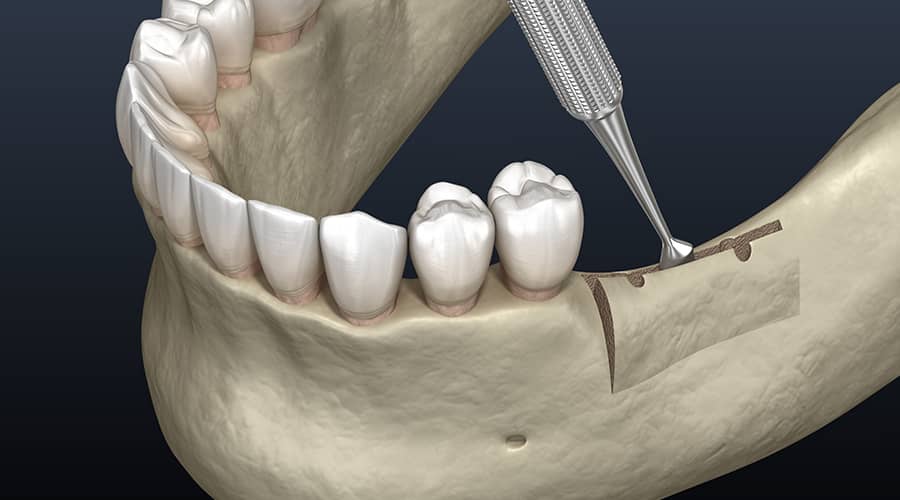
Ridge augmentation surgery is a dental procedure used to restore and reshape the gums and jawline after tooth extraction. This treatment aims to help maintain the integrity of the surrounding gum tissue and jawbone that may have been affected by periodontal disease or other medical conditions resulting in bone loss. This procedure can also be used to give more support and stability to any remaining teeth in the area.
Why a Ridge Augmentation Is Needed
The most common reason for this type of augmentation is tooth loss or trauma due to gum disease or injury, which causes a decrease in the height of the gums.
The alveolar ridges are the two ridges in the jawbone that hold the teeth in place. The alveoli is the bone surrounding the tooth root. When a tooth is lost or removed, the alveolar ridge height decreases, decreasing overall gum health and aesthetics.
When you experience tooth loss, these sockets remain open, eventually healing with natural tissues. But sometimes, the bone around the socket is broken or deteriorated and cannot heal properly, leading to a decrease in ridge height. Before a dental implant procedure can be performed, this bone must be reconstructed.
Through ridge augmentation surgery, bone grafts from somewhere else in your body or artificial calcium-based materials can be placed in these sockets rebuilding the natural bone to its original height. This procedure creates a strong foundation for implants or dentures when implanted later.
The Ridge Augmentation Procedure
Ridge augmentation is an outpatient procedure that takes approximately 1-2 hours. The surgeon will make an incision in your gums to expose the jawbone. They will insert the bone or tissue graft material into the alveolus. The gums will then be stitched together, promoting proper healing and restoring lost bone density in the area.
Depending on the graft material used, it can take several weeks to months for your ridge to fully recover post-surgery. You will return for regular checkups while you heal so your surgeon can check how the bone graft is healing. Once they are satisfied with the result, you will be able to proceed with the dental implant or dental procedure.
Ridge augmentation is an outpatient procedure performed at our clinic. We use local anesthesia to minimize discomfort and offer other forms of sedation, such as Nitrous Oxide, to make the procedure more comfortable. Speak to your surgeon about other options that may be better suited for you.
Am I a Good Candidate for Ridge Augmentation?
Ridge augmentation is a great procedure for anyone who needs to restore the natural shape of their teeth and gums. This procedure can also help provide more stability to any remaining teeth in the area and create the necessary foundation for dental implants. If you have recently undergone tooth extraction or other trauma that has caused a decrease in your ridge height, then ridge augmentation may be a necessary treatment for you.
Are There Any Risks?
Ridge augmentation is considered a safe and effective procedure. However, as with any surgical procedure, some risks are associated. These may include infection, nerve damage, swelling or pain at the surgery site, and delayed healing. Your surgeon will be able to discuss all of these risks in more detail with you before beginning the procedure.
What Is a Combination Ridge Augmentation?
Combination ridge augmentation is a technique that combines a dental bone graft with soft tissue grafts to restore the alveolar ridge. This technique is often used if significant bone loss has occurred due to periodontal disease or trauma. The surgeon will insert a bone graft material, such as donor, synthetic, or autogenous bone, into the alveolus. They will then cover this with a soft tissue graft taken from your own cheek or gums.
Summary
- Ridge augmentation surgery is a dental procedure used to restore and reshape the gums and jawline after tooth extraction.
- When a tooth is lost or removed, the alveolar ridge height decreases, decreasing overall gum health and aesthetics.
- Depending on the graft material used, it can take several weeks to months for your ridge to fully recover post-surgery.
- This procedure provides more stability to any remaining teeth in the area and creates the necessary foundation for dental implants.
- Risks include infection, nerve damage, swelling or pain at the surgery site, and delayed healing.
Oral Surgeon Deer Park
If you are considering dental implants and want to learn more about ridge augmentation, contact our clinic today. Our team of experienced and knowledgeable surgeons at Oral Facial and Implant Specialists can help you find the best solution for your oral health needs. We will make sure that you understand all of your treatment options and discuss any potential risks associated with them.
If you are searching for ridge augmentation in Deer Park or Barrington, oral surgeon Deer Park, or dental implants Deer Park, we can help. Call (847) 381-0106 or complete the online booking form to schedule a consultation.
Call UsFrequently Asked Questions
Ridge augmentation is a relatively simple procedure and usually does not cause much discomfort. Your surgeon will use local anesthesia to make sure that you remain comfortable throughout the entire process. Pain medication will help relieve discomfort after the surgery.
The recovery time for ridge augmentation varies depending on what type of graft material was used during the procedure. Generally, you can expect it to take anywhere from several weeks to a few months for your ridge to heal properly.
Your stitches will usually dissolve on their own after a week or so, However, you may need to come back for a follow-up appointment so your surgeon can check how well the stitches are dissolving. Do not pull on the stitches, as this can cause the wound to reopen.
The cost of ridge augmentation can vary depending on the type and complexity of your procedure. Your surgeon will be able to give you an accurate quote for your treatment plan during your consultation.
